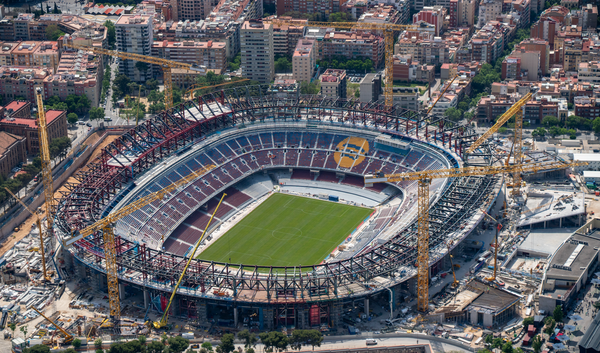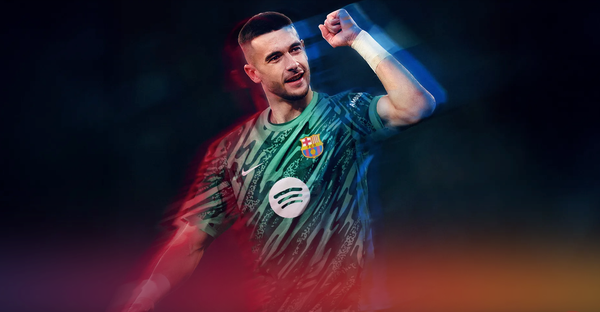Inverting the script: Xavi's formula to unleash Sergiño Dest at Barcelona
Dest’s driving with the ball. Progressive runs, in particular, are something that immediately catches the eye when you watch him play.

There is this running joke among Barcelona fans that Dani Alves is their best right-back since Dani Alves. Or my personal favourite - Barcelona have finally found their Dani Alves replacement after years and years of searching and his name is… Dani Alves. But the best thing about these jokes is that they’re funny, yes, but also very true. Many have tried replacing the Brazilian over the years and all of them have failed. In comes Sergiño Dest.
To be perfectly honest, however, the now 21-year-old former Ajax talent has struggled since his transfer too. Occasional moments of brilliance were mostly coupled with unconvincing performances and with Xavi’s arrival, the young American looked to be completely out of the squad. However, a switch flipped and now, Dest is back. But what has changed so quickly and drastically?
I’ve been an advocate of Dest the inverted right-back for a very long time and now, we’re finally seeing his true colours in a variation of that role under Xavi. The new Barça coach deploys a system that sees the right-back tuck inside and operate as a false pivot, providing progression and compactness among other things. I’ve explored this new system and its features in a separate analysis on the site so won’t go into detail about it here.
But many were under the impression Dest wouldn’t work well in this role. I disagree. Despite his speed, crossing and 1v1 proficiency, he is not your traditional overlapping full-back - he never was. In this piece, I’ll take a look at what made him so good back at Ajax and how this new role at Barcelona suits his traits perfectly.
Setting the parameters
Before we start analysing Dest, it’s important to understand what exactly we’re looking for. An inverted right-back is very different to an overlapping one. The obvious difference is in the space they occupy but it’s also in the traits that make someone compatible with the role. An overlapping full-back needs to be a penetrative outlet with a deadly final third presence, ie something like Jordi Alba. Of course, you can have a full-back with an elite delivery overlapping and bombarding the box from the outside too without them being pacey 1v1 specialists. This is also true.
But when you operate with inverted forwards or false wingers, you need the width and verticality provided from a different source. Dest is not that source. The simple reason being you cannot coach that into a player; Xavi can’t just flip Dest’s profile entirely and turn him into a penetrative winger when his entire tool kit is suited to a different role. Yes, he is decently fast and good in 1v1s but he can’t conquer large territory nor is his natural instinct to attack space relentlessly. On the other hand, some of the attributes he presumably lacks for an inverted role and associative football are alertness, awareness of his surroundings/teammates and some defensive concepts such as using his cover-shadow well. Those things are all coachable.
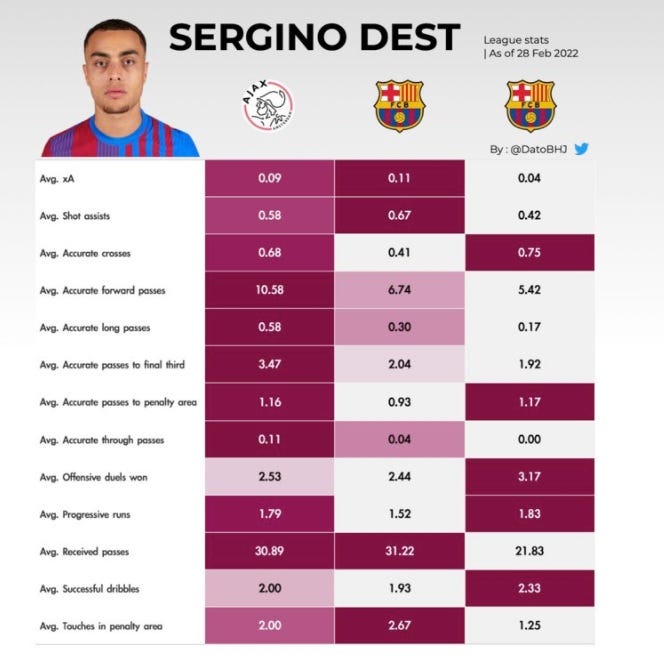
Above, you can see the main differences between Ajax’s Dest and Barcelona’s Dest pre and under Xavi. Perhaps unsurprisingly and despite him playing in a possession-heavy team such as Barcelona, Dest’s associative traits are much more emphasised at Ajax. Yes, the Dutch side is also very possession-oriented but maybe not to the same extent as the Catalan club. And yet, Dest was connecting the thirds more, was more of a passer than an outlet and more of a progressor than a wide threat at Ajax than at Barcelona. Be wary of the third column, however, as the sample is VERY small there.
But in this analysis, I’ll mainly be looking at Dest’s positioning, movement, passing & driving with the ball to determine whether he fits Xavi’s vision of an ideal right-back at Barcelona. This includes but is not limited to how he receives under pressure, how well he drives with the ball after beating a marker, his ability in tight spaces, movement/occupation of space in relation to others, intent on the ball, comfort in that midfielder role once inverted, comfortability in exploiting multiple angles provided by this new role and timing of releasing passes.
There is, of course, a big defensive part present too but will have to be analysed on a different occasion - how good is he at using his cover-shadow and defending half-spaces? Is he alert in transitions? Is he aware of and can deal with markers dropping deep? These are all questions that need to be answered when judging his suitability for the role. But none of the aspects mentioned are contradictory to his profile and all can be improved/implemented with proper coaching.
This is key. So without further ado, let’s get straight into it.
(Re)Positioning & movement
One of the main aspects an inverted full-back needs to master are positioning and movement. Whereas the traditional wide defender operates within a very limited, albeit vertical sphere, the inverted one acts as a midfielder. As such, he is arguably given more to do and a bigger hand in influencing the build-up phase of the game, especially in a possession-dominant side such as Barcelona. In that regard, recognising when and where to move in relation to others is absolutely key.
It may not seem so at first because he was utilised wrong prior to Xavi’s arrival, but Dest is very good at this. He scans his surroundings regularly and understands what movement will benefit his teammates. Below is a very small detail that many may have missed but at the same time, it’s very important too.
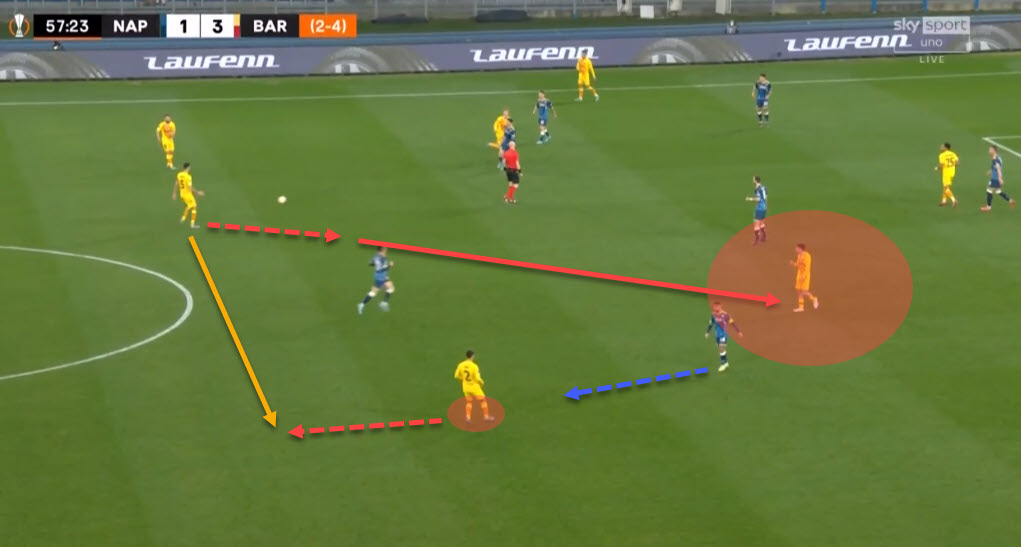
This is what I mean by saying ‘movement relative to others’. Against Napoli, Dest regularly tucked in but more importantly, we’re starting to see his understanding of the game and the system around him. As soon as Sergio Busquets receives the ball, Dest recognises he needs to drop deeper and it does two things: Firstly, it gives Busquets a new channel to exploit should a vertical pass be impossible. Secondly, it attracts markers and breaks Napoli’s defensive structure, ultimately leading to dismarking Pedri, who receives a pass soon afterwards.
It’s this type of movement and awareness that bodes extremely well for the future and it shows Xavi is drilling it into Dest. But it’s at this point that we have to look at his time at Ajax once more. You see, as much as the majority of people would tell you Dest isn’t used to playing in this role, that is completely wrong. In fact, he’s always been a more inverted right-back and stating the opposite means you haven’t watched him at Ajax.
Below you can see Dest’s touch maps from his final days in the Netherlands with a big enough sample (minutes + actions). The results speak for themselves.
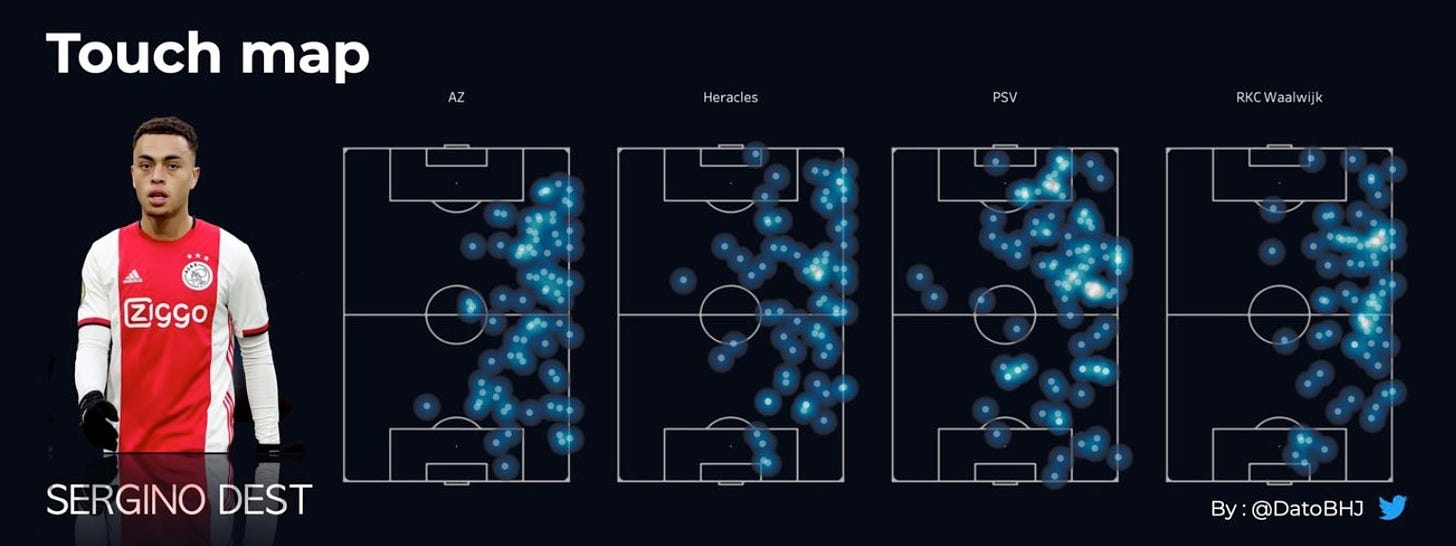
Notice how a big number of his actions indeed stem from a more central position, occupying that half-space. Dest is very much used to operating in that area and I’d even go as far as saying he excels at it. His starting position at Ajax was mostly wide but in settled phases of possession or upon receiving the ball, he’d often cut inside towards the centre.
This isn’t a surprise given his immense technical quality. He is very good in tight spaces, press-resistant and can progress play, all of which we’ll see shortly. But let’s stick with movement, awareness and (re)positioning. The next couple of GIFs will help us understand this aspect of his profile which has been unrightfully deemed lacking.
For our first example, we’re watching a clip from Ajax’s 2:0 defeat at the hands of Utrecht. But despite the defeat, Dest showed some excellent qualities in an inverted role.
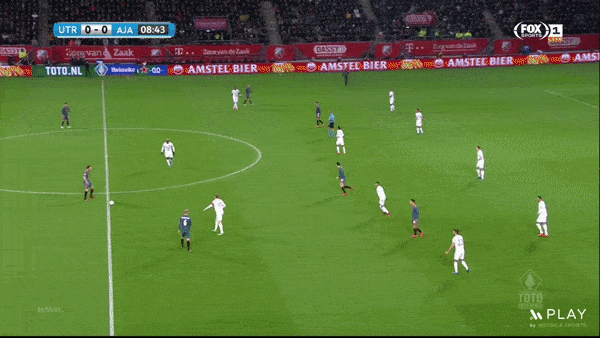
Our protagonist starts the action already in the central corridors. There, he scans his surroundings multiple times to see whether he's free to receive possession in what is usually a very busy and often tightly-marked area. Notice that he first moves even more towards the centre to open a passing channel for his teammate, scans to see how much time he’ll get on the ball and immediately knows where to recycle it to once it gets to him.
The link-up is pretty basic, one-touch pass but it’s nicely controlled and accurately laid off. The movement following it, however, is even more important. By drifting further upfield in a diagonal direction, Dest pulls the marker away and opens yet another passing channel for his teammate. Once in the final third, he again recognises where to move to put the opposition into a decisional crisis: do I follow his run to the outside and then leave the man on the ball unmarked or do I stick with the player in possession but risk having Dest completely free on the flank?
Moving onto the next example, this one comes from Ajax’s game against AZ Alkmaar and it follows a similar pattern.
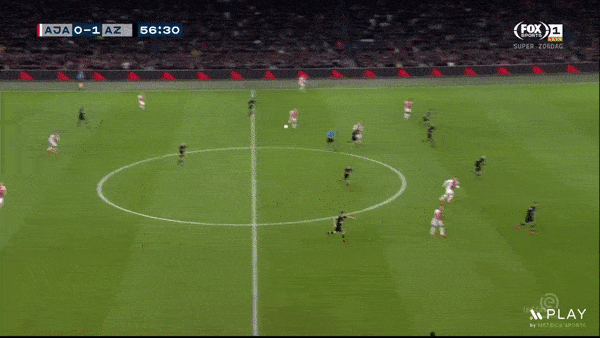
This time, however, Dest receives possession out wide, which was still the more likely option. But quickly afterwards, he cuts inside to combine with his teammate in a more central position. Notice how he waits for the opponent to commit to cover the channel to his right before deploying the pass. This ensures the defender is already going in the opposite direction to the one he’s taking. After that, he moves into a good position to complete the one-two and then it’s la pausa once again.
Dest stops for a second, waits for his marker to commit and then passes back to his teammate who is unmarked for a second. Knowing the sequence has now attracted another defender from the backline, he immediately bursts into the newfound space. Even though he doesn’t receive the ball in that action, everything he’s done so far has been very good: from initial movement, occupation of space, re-positioning, passing and recognition of where and when to go next.
I loved this sequence from the game against Athletic Club. Even though it’s a failed attempt, it still shows us Dest understands Xavi’s system.
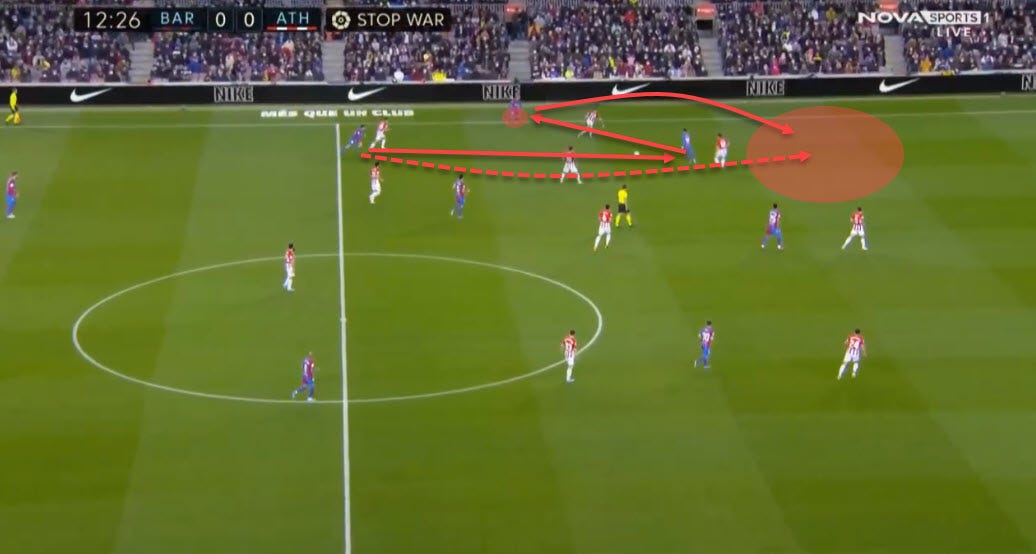
Here, Ferran Torres has cut inside, leaving the flank open for potential overlap. However, if Dest was to advance here, it would make for a very difficult link-up and would likely leave Pedri and Ferran isolated. Instead, he knows Pedri will make a run from the deep later on because that’s what Xavi wants his interiors to do. Maintaining position here even though there’s a good opportunity to burst into space shows discipline and understanding of the system.
Staying put eases the link-up because of the triangle it creates and once he receives the lay-off from Ferran, Dest attempts a pinged ball over the top and into Pedri’s path. Sadly the pass doesn’t find its mark but it still tells us a lot about our protagonist. Coincidently, it is also a good segue into the next section of our analysis.
Passing & driving with the ball
Ability off the ball in regards to reading the game, positioning and movement is crucial, but Barcelona’s inverted right-back will have to be very good on the ball as well. If we look at Alves again, he is the type of a full-back who has successfully transitioned into a midfield role during his time away from Barcelona. But it’s his tool kit and technical quality that make him an excellent combinatory option that can invert into a false pivot. Dest is very similar.
We’ve seen in the previous section how that’s something he did often at Ajax and given his exceptional technical quality and room for growth, it’s fair to assume he can replicate it at Barcelona too. I want to address the passing first because I feel that’s the area that still needs to be more developed in possession. Alves is very comfortable with the ball at his feet and he can connect thirds, playmake and retain possession. Dest has the foundation to get there too but needs to show more intent and better exploitation of multiple angles. Let me explain.
A more traditional full-back is mostly positioned out wide and therefore operates with far more limited angles because of the touchline that’s always to one of his sides. But when you move the player closer to the centre, different angles open up and you suddenly get more options. While that sounds good, not all players react well in such scenarios. Some of them get very indecisive while some can recognise the angles but are unable or just unwilling to exploit them. Dest still struggles with a similar issue.

Even when he was at Ajax, inverting provided him with more angles to exploit but he didn’t always take them. For instance, in the example above, instead of trying to find runners behind the opposition’s line, he opts to dribble to the outside and then back where he started, slowing down the attack. This isn’t a big issue because it can be fixed.
However, with Dest, sometimes you can tell it’s a right-back operating as a midfielder rather than a natural midfielder. With Alves, on the other hand, you can already tell he’s very accustomed to the role he’s been given. But this is not to say Dest is always indecisive and ineffective. The young American indeed has it in his locker to deploy such passes. After all, that’s one of the things that make him suitable for the role.
Below are pass maps from some of his last games at Ajax and they do tell quite a story.
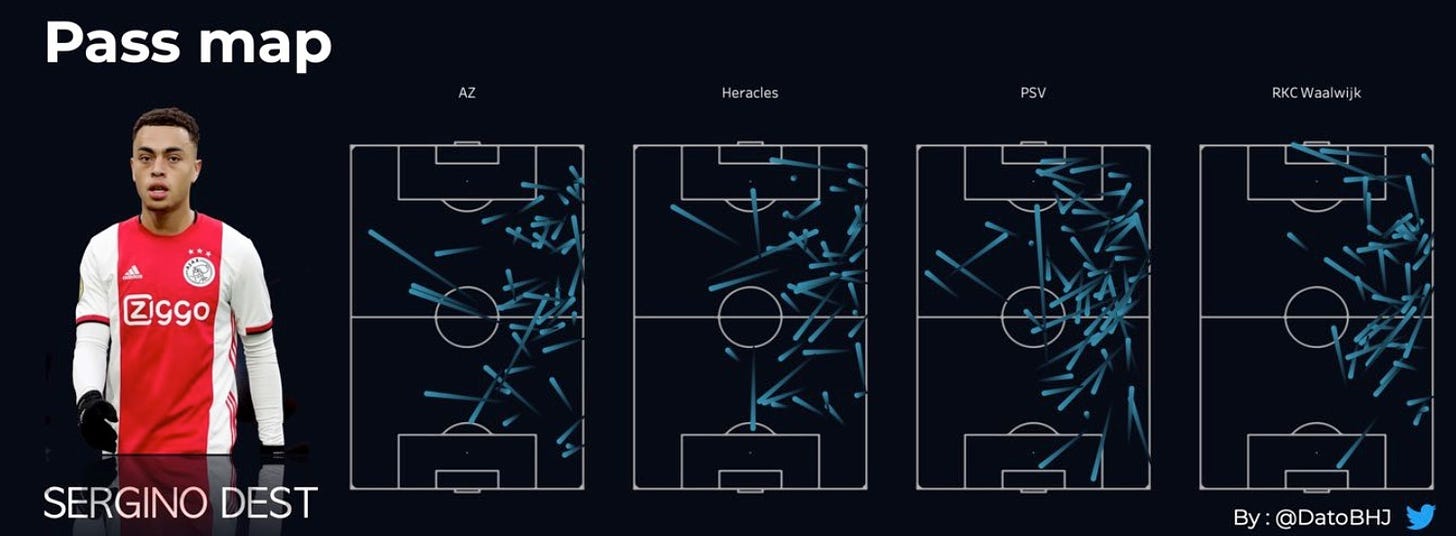
We can see that when glued to the touchline, Dest doesn’t have many options to choose from; his passes range from short/medium vertical attempts or backwards diagonals from a slightly higher position. However, the more you move towards the centre, the more variety appears on the map. We can see long diagonals, passes into zone 14, passes from the half-space into the flanks and short combinatory passes that are used in the build-up.
When given a platform to showcase that variety, Dest can absolutely do it. The key is giving him the freedom to express that side of his player profile. Let’s look at a couple of GIF examples for more proof. The first one comes from that excellent Napoli game and it will show us Dest’s intent on the ball as well as his technical quality.

Here, we see him control a long ball and immediately beat the marker in his close vicinity. But he also moves inwards, which opens up the pitch for multiple different angles to exploit. Suddenly, he has options to choose from but despite having the right body orientation for a potential right-footed diagonal, he opts against it, passing towards Adama Traore on the right instead.
Eventually, however, when given the ball back, he again opens his body to a switch, only this time he takes it and executes really well. It’s this kind of (in)decisiveness that will be key in his development in the inverted role. Dest is bound to be faced with such situations more often than not as Barcelona dominate possession, switch flanks quickly or maintain pressure on the opposition. He has to be able to be decisive but also quick in making those decisions.
There is also one more attacking aspect I want to touch upon here - Dest’s driving with the ball. Progressive runs, in particular, are something that immediately catches the eye when you watch him play. It was evident at Ajax and it’s still evident at Barcelona. And Xavi has recognised it too - Dest is very technical, an excellent dribbler and fairly press-resistant, making him akin to Frenkie de Jong when he inverts, only without the elegance with with the Dutchman flies across the pitch and without Frenkie’s athleticism too. But the core elements are there - Dest will beat his man, sometimes effortlessly as we’ve seen in the previous video, and will then drive forward with the ball.
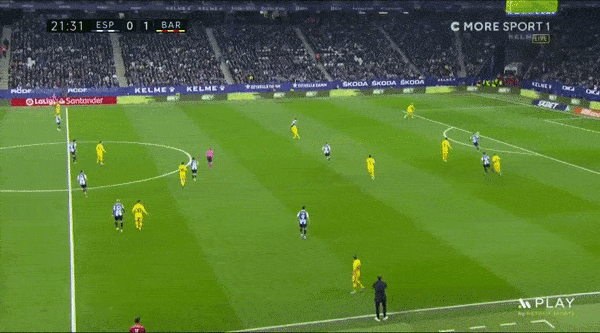
The clip above was taken from Barcelona’s 2:2 draw against Espanyol, the game in which we saw Dest struggle in the inverted role. However, while it was easy to focus on the negatives, there were some positives and shades of what’s to come. For instance, that sequence was exactly how Xavi envisioned Dest to operate. He has no problems receiving possession with a man on his back, beating that marker and then driving into open space for a link-up higher up the pitch.
This is the Dest-special and a move I’ve no doubt we’ll see often in the future too. The 21-year-old is very effective on the half-turn and will easily escape the immediate pressure behind his back. This makes him very valuable in beating the press and progressing play. Let’s explore a fairly similar sequence next.
Down below, Dest does almost exactly the same thing against Valencia. He controls the long ball with a silky first touch and then proceeds to beat his man instantaneously.
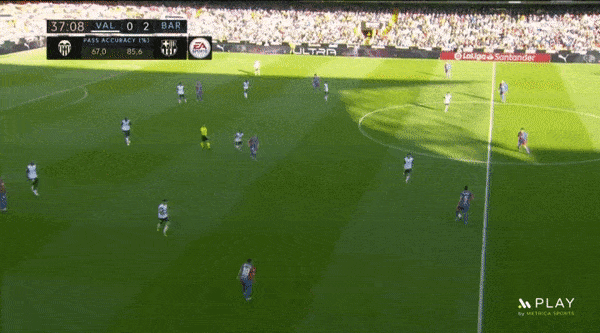
But there’s also more to take away from this sequence. Inverted full-backs who can act as false pivots usually give more freedom to interiors to operate in advanced areas. The progression, central compactness and press-resistance are enhanced and aided by the full-back so they get the leisure of staying higher. Here, however, Dest opts to attack the space that was created both by his own run and by one of his teammates dragging the marker away.
His burst of pace from a higher starting position can be used as a penetrative outlet in that case and also fits Xavi’s idea of very aggressive interiors who make runs through the half-space. Again, recognising the space that can be conquered and then exploiting it. After that, the same thing - recognising the space that can be conquered as the direct result of his own and his teammate’s actions and then exploiting that too. An excellent passage of play.
Finally, I’d like to include one more example of Dest receiving with a player on his back, showcasing he can indeed operate in tight spaces and is very press-resistant.
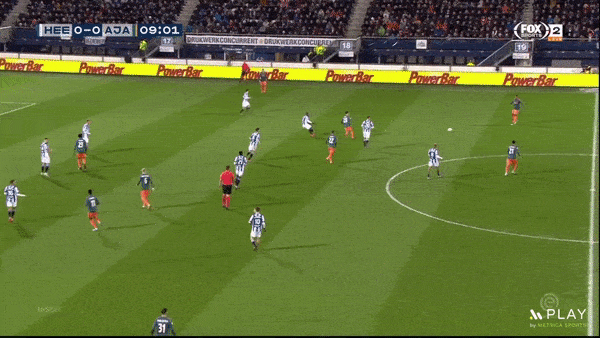
Again, he scans his surroundings before receiving possession so he knows the marker will be on him as soon as that happens. But he is excellent in such situations and immediately disposes of the defender, progressing towards the outside to link up with a teammate. It’s also interesting to note how he moves from there too.
Seeing how his teammate remained in his position, Dest was the one to run into the space behind the opposition’s backline. In the end, nothing comes out of it and he doesn’t get the ball but just the fact he made the right run is a positive sign.
Final remarks
We’ve already seen shades of what Dest could become under Xavi and if he continues developing in the same manner, his future will be bright. Barcelona are, however, still on the market for new full-backs, which is understandable given their lack of depth but the young American should not be discarded so easily.
In this analysis, I’ve attempted to demonstrate some of his qualities that will make him a good choice for the type of full-back Barcelona want and need. However, the defensive side of his profile will be equally as important. Sadly, given this article is already very long, I’ve opted to leave it for a different time. The qualities have been listed at the beginning so we know how to judge him in that aspect moving forward.
It’s very difficult to predict whether he’ll actually fulfil his potential but the early signs under Xavi are good. Long may it continue.

